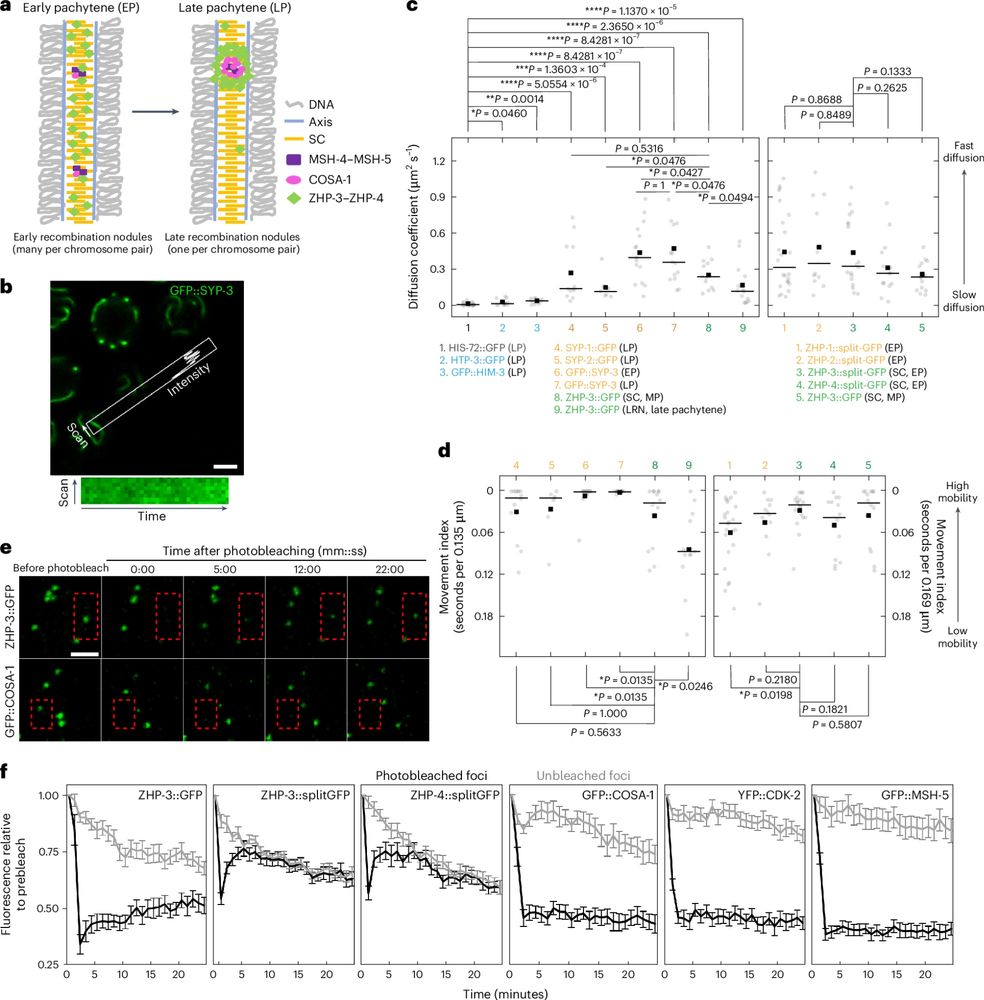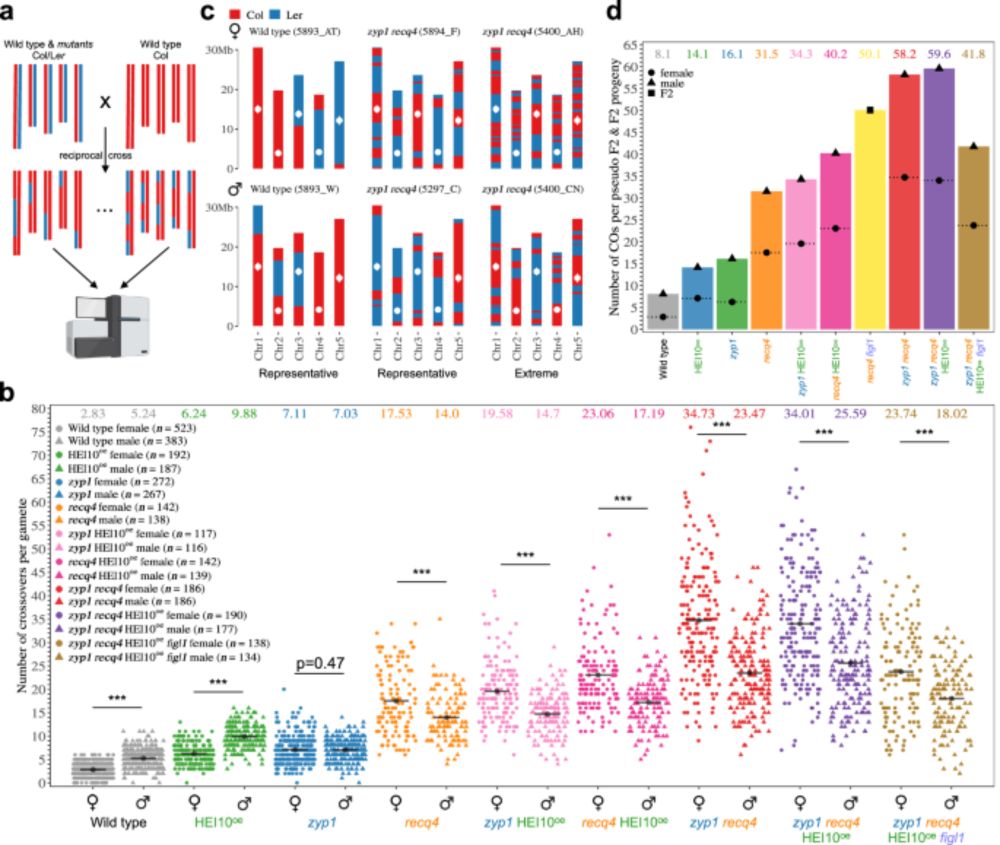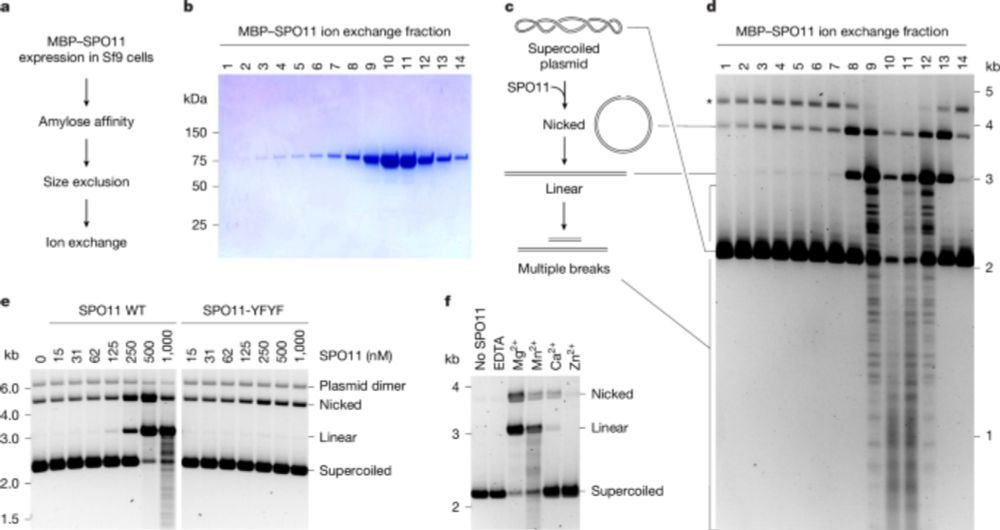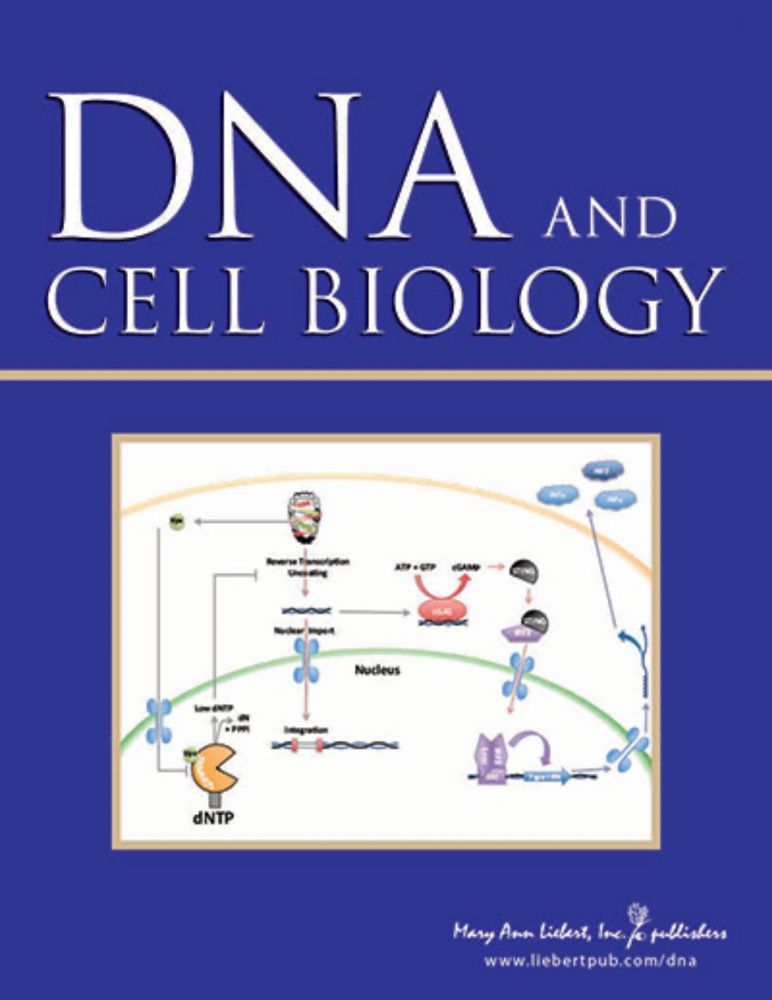This work was led by my research technician Pascaline Liloku. Congratulations to her! I thank our collaborators, in particular the team of David Alsteens for help with AFM experiments, and Yann Sterckx for SAXS experiments. Finally, big thanks to the ERC and FNRS for funding!
28.09.2025 18:14 — 👍 0 🔁 0 💬 0 📌 0
Do we have any evidence to support this?
And does the DNA-binding activity of Spp1 have any functional consequences?
To find out, check out the paper!
28.09.2025 18:14 — 👍 0 🔁 0 💬 1 📌 0

We think that the binding of Spp1 to Mer2 occludes part of the DNA-binding interface of Mer2. However, the cost associated to Spp1 binding is compensated by a DNA-binding motif contributed by Spp1. We refer to this as an occlusion-compensation model.
28.09.2025 18:14 — 👍 0 🔁 0 💬 1 📌 0
So, how then do Mer2-DNA and Mer2-Spp1 interactions relate to each other? In other words, are the binding of DNA and Spp1 to Mer2 independent? Or are they competitive? Or in contrast are they cooperative?
We think there is yet another possibility.
28.09.2025 18:14 — 👍 0 🔁 0 💬 1 📌 0

So how does Spp1 bind DNA? Again AlphaFold proved helpful and pointed to a motif required for DNA binding.
Mutating this motif confirmed that, although full-length Spp1 does not bind DNA by itself, it binds DNA in the context of a complex with Mer2.
28.09.2025 18:14 — 👍 0 🔁 0 💬 1 📌 0

While full-length Spp1 does not bind DNA by itself, a truncation of Spp1 bound DNA quite efficiently. Thus, DNA-binding appears to be auto-inhibited in the context of the full-length protein.
That was surprise 3.
28.09.2025 18:14 — 👍 0 🔁 0 💬 1 📌 0
So how does Spp1 affect DNA binding and condensation?
We expected that DNA and Spp1 might compete for access to Mer2, but that doesn't seem to be the case. Instead Spp1 seems to somewhat stimulate DNA binding and condensation by Mer2.
Does Spp1 contribute to DNA binding directly?
28.09.2025 18:14 — 👍 0 🔁 0 💬 1 📌 0

Mer2 forms DNA-dependent condensates and effectively recruits Spp1.
Spp1 is essentially recruited as a client, but Spp1 does seem to stimulate condensation a little.
28.09.2025 18:14 — 👍 0 🔁 0 💬 1 📌 0

Now on two the second surprise: The Mer2 coiled coil domain that binds Spp1 is also involved in DNA binding.
We reconstituted Mer2-Spp1-DNA complexes and used AlphaFold to visualize what these complexes might look like.
(these models look pretty cool but are to be taken with a big grain of salt)
28.09.2025 18:14 — 👍 0 🔁 0 💬 1 📌 0

We verified that the previously-reported 4:2 stoichiometry was right. Indeed it was. Yet SAXS analysis all fit with the AlphaFold model.
There are several possible explanations: Our favorite is that the binding of Spp1 to Mer2 is allosterically regulated. (our arguments are in the paper).
28.09.2025 18:14 — 👍 0 🔁 0 💬 1 📌 0

However, there is an issue: based on the AlphaFold model, it is not clear why Mer2 and Spp1 would assemble a complex with a 4:2 stoichiometry, as had been shown previously. Mer2 is a homotetramer, and based on the model, it could accommodate 4 Spp1 subunits. That's our 1st surprise.
28.09.2025 18:14 — 👍 0 🔁 0 💬 1 📌 0

An mutagenesis analysis of the predicted interface provided evidence that supports the model.
28.09.2025 18:14 — 👍 0 🔁 0 💬 1 📌 0

We used AlphaFold to model the structure of the Mer2-Spp1 interaction domain, revealing a cool model with two Spp1 bound to a tetrameric Mer2 coiled coil.
28.09.2025 18:14 — 👍 0 🔁 0 💬 1 📌 0

We set out to characterize the interaction between Mer2 and Spp1.
We developed an approach based on atomic-force microscopy to measure single-molecule Spp1-Mer2 interactions, revealing a dynamic interaction.
28.09.2025 18:14 — 👍 0 🔁 0 💬 1 📌 0

Meiotic double-strand break (DSB) formation is tied to the loop-axis organization of meiotic chromosomes. DSB proteins are localized to the axes, and Spo11 cleaves DNA within loops. Spp1 connects the loop to the axes by binding H3K4me3 marks within loops and the DSB protein Mer2 on the axis.
28.09.2025 18:14 — 👍 0 🔁 0 💬 1 📌 0
Institut Curie hiring Postdoctoral Position in Mammalian DSB Repair (F/M) in Paris, Île-de-France, France | LinkedIn
Posted 8:04:09 PM. About UsInstitut Curie Research CenterInstitut Curie is a major player in the research and fight…See this and similar jobs on LinkedIn.
We are hiring!
We are looking for a motivated and enthusiastic postdoc to study mammalian DSB repair using innovative genomic approaches.
Our lab is at the Curie Institute in Paris and offers vibrant scientific environnement and cutting edge platforms.
Please repost or apply here:
lnkd.in/eJ9q3QrR
01.08.2025 09:38 — 👍 1 🔁 5 💬 0 📌 0
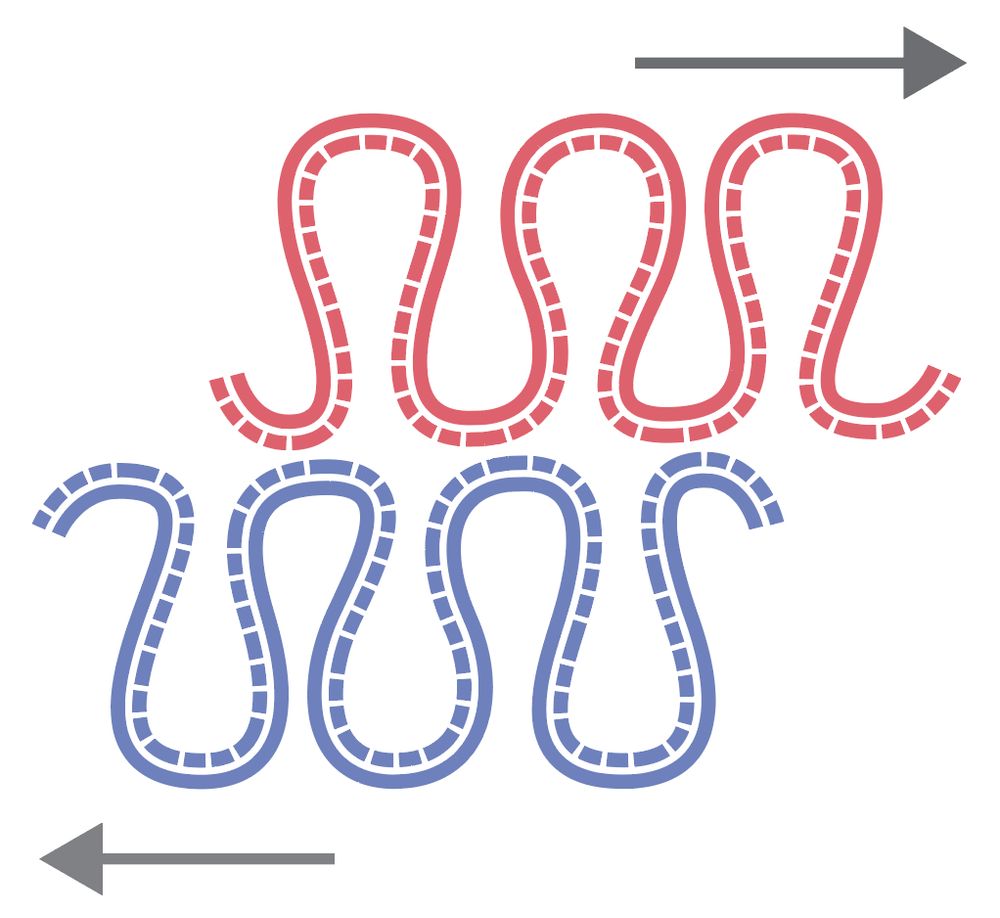
We found a new asymmetry in the large-scale chromosome structure: sister chromatids are systematically shifted by hundreds of kb in the 5′→3′ direction of their inherited strands! The work was led by Flavia Corsi, in close collaboration with the Daniel Gerlich lab.
www.biorxiv.org/content/10.1...
1/
15.07.2025 08:11 — 👍 111 🔁 58 💬 3 📌 7
Thank you Valérie!
11.07.2025 18:10 — 👍 0 🔁 0 💬 0 📌 0
Recruitment of Mre11 to recombination sites during meiosis
The Mre11 nuclease, part of the conserved MRX complex involved in the repair of DNA double-strand breaks (DSBs), is also essential to initiate meiotic recombination in budding yeast by promoting Spo11-induced DSBs. Recruitment of Mre11 to meiotic DSB sites depends on Rec114-Mei4 and Mer2 (RMM) that organize the meiotic DSB machinery by a mechanism involving biomolecular condensation. Here, we explored the role of Mre11 during meiosis and its relationship to RMM condensation. We show that both Mre11 and MRX complexes form DNA-dependent, hexanediol sensitive condensates in vitro. In vivo, Mre11 assembles into DNA damage-dependent foci in vegetative cells and DSB-independent foci in meiotic cells. In vitro condensates and in vivo foci both depend on the C-terminal intrinsically-disordered region (IDR) of Mre11. Importantly, while the Mre11 IDR is dispensable for vegetative DNA repair it is essential during meiosis. The C-terminus of Mre11 forms a short alpha-helix that binds a conserved region of Mer2, and mutating residues within this interface reduces Mre11 foci and DSB formation. Finally, we identified a SUMO-interacting motif within the Mre11 IDR that enhances recruitment of Mre11 during meiosis and facilitates DSB formation. This work identifies multiple mechanisms that collaborate to recruit Mre11 during meiosis to initiate recombination. ### Competing Interest Statement The authors have declared no competing interest. European Research Council, 802525 Fonds National de la Recherche Scientifique, Bruxelles, BE, T.0031.22 Research Council VUB, SRP95, OZR3939 National Institute of Health, US, R01GM074223
We’re happy to present a new preprint from the lab, where we identify new mechanisms that drive the recruitment of Mre11 to recombination sites during meiosis. Work led by star student Priyanka Priyadarshini with help from colleagues and funded by the ERC and FNRS.
www.biorxiv.org/content/10.1...
09.07.2025 05:56 — 👍 7 🔁 5 💬 1 📌 0
Recruitment of Mre11 to recombination sites during meiosis
The Mre11 nuclease, part of the conserved MRX complex involved in the repair of DNA double-strand breaks (DSBs), is also essential to initiate meiotic recombination in budding yeast by promoting Spo11-induced DSBs. Recruitment of Mre11 to meiotic DSB sites depends on Rec114-Mei4 and Mer2 (RMM) that organize the meiotic DSB machinery by a mechanism involving biomolecular condensation. Here, we explored the role of Mre11 during meiosis and its relationship to RMM condensation. We show that both Mre11 and MRX complexes form DNA-dependent, hexanediol sensitive condensates in vitro. In vivo, Mre11 assembles into DNA damage-dependent foci in vegetative cells and DSB-independent foci in meiotic cells. In vitro condensates and in vivo foci both depend on the C-terminal intrinsically-disordered region (IDR) of Mre11. Importantly, while the Mre11 IDR is dispensable for vegetative DNA repair it is essential during meiosis. The C-terminus of Mre11 forms a short alpha-helix that binds a conserved region of Mer2, and mutating residues within this interface reduces Mre11 foci and DSB formation. Finally, we identified a SUMO-interacting motif within the Mre11 IDR that enhances recruitment of Mre11 during meiosis and facilitates DSB formation. This work identifies multiple mechanisms that collaborate to recruit Mre11 during meiosis to initiate recombination. ### Competing Interest Statement The authors have declared no competing interest. European Research Council, 802525 Fonds National de la Recherche Scientifique, Bruxelles, BE, T.0031.22 Research Council VUB, SRP95, OZR3939 National Institute of Health, US, R01GM074223
We’re happy to present a new preprint from the lab, where we identify new mechanisms that drive the recruitment of Mre11 to recombination sites during meiosis. Work led by star student Priyanka Priyadarshini with help from colleagues and funded by the ERC and FNRS.
www.biorxiv.org/content/10.1...
09.07.2025 05:56 — 👍 7 🔁 5 💬 1 📌 0
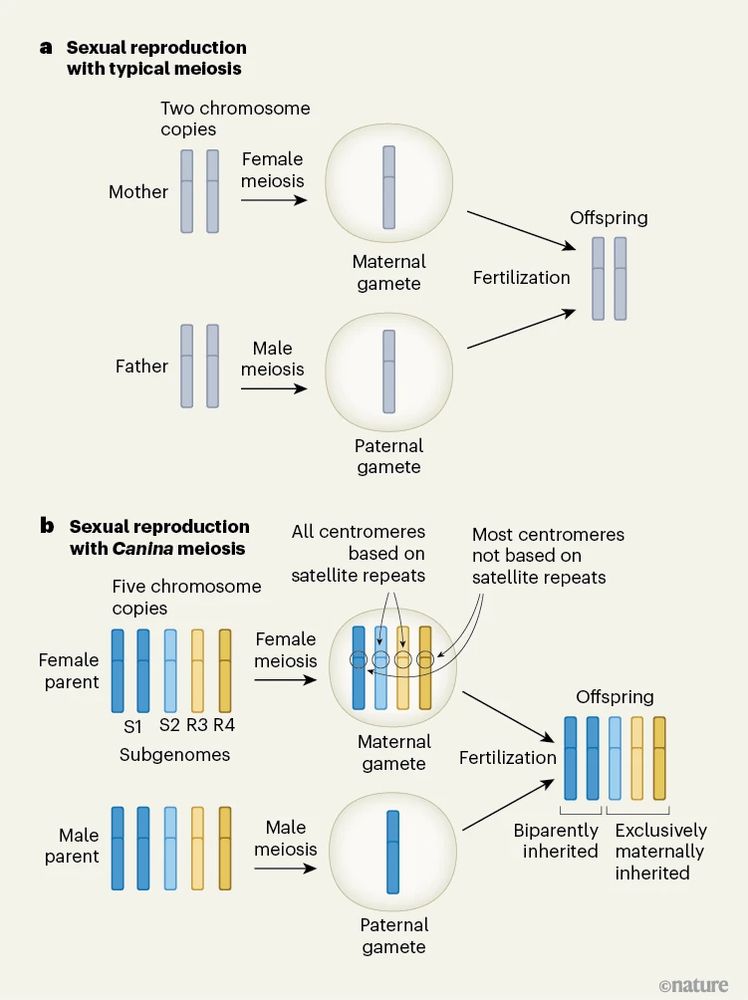
Diagram of two types of reproduction based on their meiosis. A. shows typical meiosis taking place in individuals with two copies of each chromosome (diploids) resulting in both male and female gametes carrying one copy of each chromosome. Fertilization restores the double copy for each chromosome. B. shows Canina meiosis in individuals carrying five copies of each chromosome (pentaploids) where male gametes only carry one copy of each chromosome and female gametes carry four copies of each chromosome. Fertilization restores the five copy for each chromosome.
Check out the Views & News piece that Joiselle Fernandes and I wrote for @nature.com on the recent work from @amarques.bsky.social and colleagues about one of the most bizarre ways to do meiosis rdcu.be/euabu.
Explained for non-experts!
01.07.2025 10:27 — 👍 24 🔁 13 💬 0 📌 1
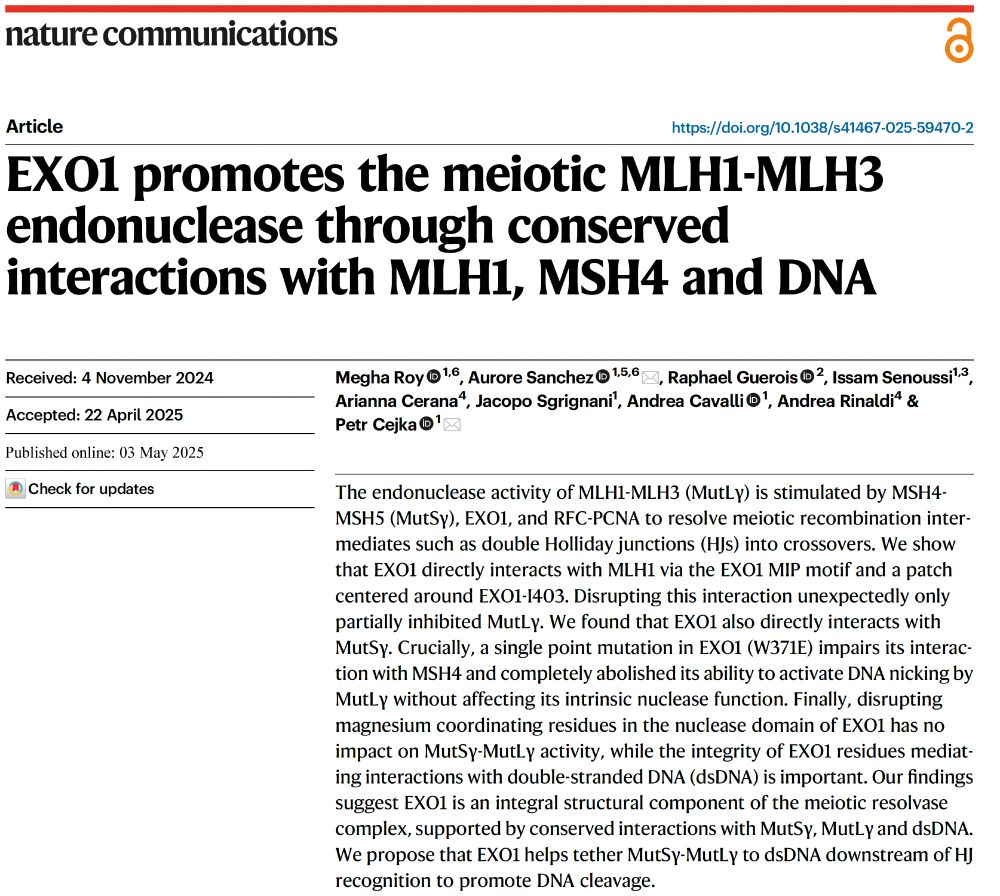
Please see our latest paper on the role of EXO1 in meiosis: "EXO1 promotes the meiotic MLH1-MLH3 endonuclease through conserved interactions with MLH1, MSH4 and DNA". Congratulations to both first authors, Megha Roy and Aurore Sanchez and thanks to all our collaborators!
05.05.2025 07:22 — 👍 45 🔁 11 💬 0 📌 0
Professeur des universités — Université libre de Bruxelles — Physicien
PhD student at ENS de Lyon studying chromatin remodeling and histone variants, mainly in the cricket Gryllus bimaculatus
Data visualisation designer at BBC News focusing on satellite data, climate change and cartography | previously at @esa.int | Co-founder of @chartle.cc - A daily chart game
Investigating origins and vulnerabilities of cancer chromosomal instability at the Barts Cancer Institute, London UK. Www.Mcclellandlab.com
Research group at IEB studying how DNA is assembled into chromatin and how chromatin factors control plant development, stress resistance and genome stability.
X: https://x.com/pecinka_grp
Researcher at Heidelberg University Hospital
Burkard Lab | Holden Comprehensive Cancer Center | University of Iowa
Studying chromosomal instability, mitotic regulation & cancer evolution
Directed by Dr. Mark E. Burkard
Synthetic AstroBotatnist. Engineer of synthetic gene circuits in plants. 🇬🇧🇪🇺 now in 🇦🇺. He/They.
Google Scholar: http://shorturl.at/dnHVZ
Compbio blog: badgrammargoodsyntax.com
Asst. Professor of Biological Chemistry & Pharmacology, Center for RNA Biology, The Ohio State University; we study ribosomes & mRNA translation in human biology & disease; advocate for equity & diversity; www.kearselab.org
Reading, or writing, or exploring. A vet, the other kind. Or both, actually. Trained in Pathology, OTJ Prev Med. Rabies is not your friend. "Bitey and probably stinky”
PhD student @Radboud University in the NL studying Siglecs & Sialyltransferases.
Virginie Hamel & Paul Guichard Lab at University of Geneva
#cryoEM/ET❄️ and #UExM ⚗️ #ExpansionMicroscopy #TeamTomo
Genève, Suisse 🇨🇭
https://mocel.unige.ch/research-groups/guichard-hamel/overv
Professor @gdsc-sussex; studying how cells divide and how we get them to stop dividing in cancer. Interested in genetics, imaging, evolution, bioinformatics, python, rust.
Meiosis, DNA breaks, and repair. Post doctoral research fellow, Institute of Medical Sciences, University of Aberdeen.
Investigating kinase-dependent regulation of DNA replication and repair
Studying why and how behavior evolves, from mosquitoes to mole-rats | Postdoc/Leon Levy Scholar @Columbia working with Ishmail Abdus-Saboor | PhD @Princeton with Lindy McBride | 麻布/東大 alum 🇯🇵 | yukihaba.github.io
Ex-researcher turned science communicator #scicomm, cat mom
🧠🧬Neurogenetics PhD
🦄 Director @pintofscience.fr & @pintsworld.bsky.social
🎙️ @souslablouse.bsky.social, Scimple & Under the lab coat
Speaks English & Français
+🐱📷⛰️
🔗 https://www.elodiechabrol.com
Doctoral researcher at Friedrich Mischer Laboratory of Max Planck Society in Tübingen.
Intersted in structural biology, cell cycle and in vitro studies of protein-protein interactions
Grad student working in budding yeast meiosis.
#meiosis #Genetics #budding yeast #chromosome segregation

















